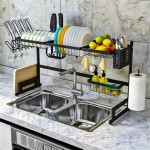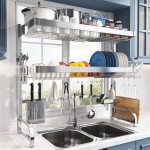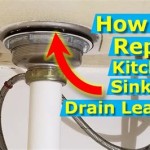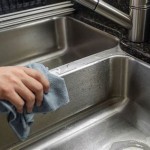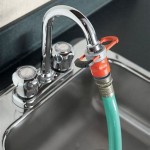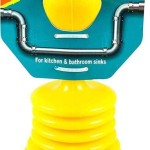Water Coming Up From Sink Drain: Understanding the Causes and Solutions
Water backing up from a sink drain is a common plumbing issue that can cause significant inconvenience and potential damage if left unaddressed. It indicates a blockage within the drainage system that prevents water from flowing freely to the main sewer line. Identifying the root cause of the backup is crucial to implementing an effective and long-lasting solution. This article explores the various reasons why water might come up from a sink drain and outlines the steps required to resolve the problem.
Understanding the plumbing system helps in diagnosing the issue. A typical sink drain system consists of several components, including the sink strainer, the tailpiece (the pipe directly below the strainer), the P-trap (a U-shaped pipe designed to trap debris and prevent sewer gases from entering the building), and the drainpipe that connects to the main drain line. Any of these components can be vulnerable to clogs that lead to water backup.
Common Causes of Water Backing Up
Several factors can contribute to water rising from a sink drain. Understanding these potential causes is the first step to resolving the problem.
Grease and Food Debris Buildup: One of the most frequent causes of sink drain blockages is the accumulation of grease, oil, and food particles. Grease, when poured down the drain, cools and solidifies, clinging to the interior walls of the pipes. Over time, this grease buildup acts like glue, trapping food particles and other debris. This gradual accumulation reduces the diameter of the pipe, restricting water flow. Starchy foods like rice and pasta can also swell in water and contribute to the blockage. Coffee grounds are another common culprit, as they tend to clump together and resist breaking down in the drain system.
Hair and Soap Scum: In bathroom sinks, hair is a prevalent cause of drain clogs. Hair strands easily get tangled and trapped in the drain, forming a dense mat that restricts water flow. Soap scum, a byproduct of soap reacting with hard water minerals, can also accumulate on pipe walls, further exacerbating the blockage caused by hair. The combination of hair and soap scum creates a sticky, stubborn mass that is difficult to dislodge.
Foreign Objects: Small objects accidentally dropped into the sink can also cause blockages. Items like toys, jewelry, cotton swabs, and feminine hygiene products can get lodged in the drainpipe, obstructing the flow of water. These objects may not immediately cause a complete blockage but can act as a nucleus around which other debris collects, eventually leading to a significant backup.
Mineral Buildup: In areas with hard water, mineral deposits like calcium and magnesium can accumulate inside the drainpipes over time. These mineral deposits, known as scale, gradually narrow the pipe diameter, restricting water flow. The buildup can be especially problematic in older pipes, where the interior surfaces are already rough and conducive to mineral adhesion. This type of blockage often requires professional plumbing assistance to remove.
Problems Further Down the Line: While the blockage might seem localized to the sink drain, the actual problem may lie further down the drainage system. A clog in the main drain line can affect multiple fixtures in the house, causing water to back up into the lowest drain, which is often a sink or shower. This type of blockage is usually more severe and requires specialized tools and techniques to resolve.
Troubleshooting and DIY Solutions
Before calling a plumber, individuals can try several DIY methods to clear a clogged sink drain. These methods are often effective for minor blockages and can save time and money.
Plunging: A standard plunger is a simple but effective tool for dislodging minor clogs. To use a plunger effectively, ensure there is enough water in the sink to cover the cup of the plunger. Create a tight seal around the drain opening with the plunger cup and then vigorously plunge up and down for several minutes. The pressure created by the plunging action can often dislodge the blockage. If the sink has an overflow drain, it should be covered with a wet cloth or tape to prevent air from escaping and reduce the effectiveness of the plunging action. Repeat the plunging process several times, checking periodically to see if the water is draining.
Hot Water Flush: For grease-related clogs, flushing the drain with hot water can sometimes melt the solidified grease and allow it to flow through the pipes. Boil a kettle of water and carefully pour it down the drain. Avoid using boiling water in PVC pipes, as it can potentially damage them. After pouring the hot water, wait a few minutes to see if the drain clears. If the water drains slowly, repeat the process. Adding a squirt of dish soap before the hot water can help break down the grease more effectively.
Baking Soda and Vinegar: A mixture of baking soda and vinegar can create a fizzing action that helps break down clogs. Pour about one cup of baking soda down the drain, followed by one cup of white vinegar. The mixture will bubble and fizz. Let it sit for about 30 minutes to an hour, then flush the drain with hot water. The chemical reaction between the baking soda and vinegar helps to loosen debris and dissolve grease. This method is generally safe for all types of pipes and is an environmentally friendly alternative to chemical drain cleaners.
Wire Hanger or Drain Snake: A bent wire hanger or a drain snake (also known as an auger) can be used to manually remove clogs from the drainpipe. Straighten a wire coat hanger and bend a small hook at one end. Carefully insert the hook into the drain opening and try to snag and pull out any visible debris, such as hair or food particles. A drain snake is a more specialized tool that consists of a flexible cable with a corkscrew-like tip. It can be inserted further down the drainpipe to reach and break up deeper clogs. When using a drain snake, rotate it as it is inserted into the drainpipe to help it break up the blockage. Exercise caution when using these tools to avoid damaging the inside of the pipes.
Cleaning the P-Trap: The P-trap is a curved section of pipe located under the sink that traps debris and prevents sewer gases from entering the building. It is a common location for clogs to form. To clean the P-trap, place a bucket under the sink to catch any water that will spill out. Loosen the slip nuts that connect the P-trap to the tailpiece and the drainpipe. Carefully remove the P-trap and empty its contents into the bucket. Inspect the P-trap for any blockages and remove them. Rinse the P-trap with water to ensure it is clear. Reassemble the P-trap, making sure the slip nuts are tightened securely. Run water into the sink to check for leaks.
When to Call a Professional Plumber
While many drain clogs can be resolved with DIY methods, some situations require the expertise of a professional plumber. Attempting to fix complex plumbing issues without the necessary knowledge and tools can lead to further damage and costly repairs.
Persistent Clogs: If DIY methods fail to clear the clog after multiple attempts, it may indicate a more severe blockage that requires professional intervention. A persistent clog could be located deep within the drainage system or be caused by a foreign object that is difficult to remove without specialized equipment.
Multiple Fixtures Affected: If water is backing up in multiple sinks, toilets, or showers simultaneously, it suggests a blockage in the main drain line. This type of blockage can affect the entire plumbing system and requires a professional plumber to diagnose and resolve.
Slow Draining: If drains are consistently slow to empty, even after attempting DIY solutions, it could indicate a partial blockage or a buildup of mineral deposits within the pipes. A plumber can use specialized tools, such as a hydro jet, to thoroughly clean the pipes and restore proper drainage.
Sewer Odor: If a foul sewer odor is emanating from the drain, it could indicate a problem with the sewer line or a broken drainpipe. Sewer odors can be harmful to health and should be addressed promptly by a professional plumber.
Signs of Pipe Damage: If there are visible signs of pipe damage, such as leaks, cracks, or corrosion, it is essential to call a plumber immediately. Damaged pipes can lead to water damage and structural problems if left unaddressed.
Lack of Experience: If individuals are uncomfortable working with plumbing or lack the necessary experience to troubleshoot and repair drain clogs, it is best to call a professional plumber. A plumber can accurately diagnose the problem and provide effective and safe solutions.
Preventive Measures to Avoid Future Blockages
Preventing drain clogs is always better than dealing with the consequences of a backup. Adopting good habits and taking proactive measures can significantly reduce the likelihood of future blockages.
Avoid Pouring Grease Down the Drain: The most effective way to prevent grease-related clogs is to avoid pouring grease, oil, and fat down the drain. Instead, collect used cooking oil in a container and dispose of it properly. Scrape food scraps and grease from dishes into the trash before washing them.
Use Strainers: Install strainers in all sink drains to catch hair, food particles, and other debris. Empty the strainers regularly to prevent buildup.
Flush Drains Regularly: Periodically flush drains with hot water to help prevent the accumulation of grease and other debris. Adding a small amount of dish soap can further enhance the cleaning action.
Regularly Clean the P-Trap: Cleaning the P-trap every few months can help prevent clogs from forming. This simple task can remove accumulated debris before it causes a significant blockage.
Avoid Flushing Inappropriate Items: Never flush items that are not designed to be flushed, such as feminine hygiene products, diapers, and paper towels. These items can cause severe blockages in the sewer line.
Consider Enzyme Drain Cleaners: Enzyme drain cleaners are a safe and effective alternative to chemical drain cleaners. They use enzymes to break down organic matter, such as grease and food particles, without damaging the pipes. Use enzyme drain cleaners regularly to help maintain clear drains.

Why Is Water Coming Out Of My Drain In Sydney Optimised Plumbing Services

Water Coming Up Through Bathtub Drain Here S Why

4 Tips To Fix A Slow Draining Sink

How To Fix Water Coming Up Through Your Sink From The Washing Laundry Machine Dishwasher

5 Reasons Why There S Water Backing Up In The Kitchen Sink Marco Plumbing Durham Greater Toronto

Water Coming Up From Bathroom Sink Drain Common Causes

Why Does Water Come Up In The Kitchen Sink Unclog A

Why Water Is Coming Up Through Your Sink And How To Fix It Home Garden

9 Blocked Sink Waste Problems Cures Q A

Why Is My Double Kitchen Sink Backing Up To The Other Side Marco Plumbing Durham Greater Toronto
